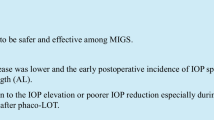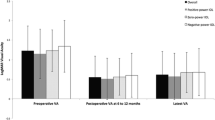Abstract
Purpose
To analyze the impact of axial length (AL) on the visual outcome and rate of perioperative complications in phacoemulsification surgery.
Design
Retrospective clinical database study.
Methods
Cataract surgery data of 217,556 eyes was extracted from the electronic medical records of 8 ophthalmic centers in the United Kingdom from July 2003 to March 2015. A total of 88,774 eyes without ocular co-pathologies were grouped eyes according to AL (mm): short AL (< 22), average AL (22–26; reference group), and long AL (> 26).
Main outcomes and measures
We analyzed visual acuity (VA) outcomes at 4 weeks, 4–12 weeks, and 12–24 weeks postoperatively, as well as the incidence of posterior capsular rupture (PCR), torn iris (TI), cystoid macular edema (CME), and retinal detachment (RD).
Results
Mean pre-operative VA (logMAR) was the worst in eyes with long AL compared to average and short AL eyes (VA 0.59 vs. 0.58 and 0.56; p < 0.001). However, post-operative VA at 4–12 weeks was slightly better in the long AL group (0.14 in short and average AL; 0.12 in long AL, p < 0.001). We observed an increased odds of TI in the short AL group (OR 2.09, 95% CI 1.60–2.75). There was increased risk of RD in long AL eyes (p < 0.001). However, PCR and CME rates were not different.
Conclusion
In the absence of any coexisting ocular pathology, AL alone did not have an impact on VA improvement or the risk of encountering PCR or CME. The risk of TI was greater in the short AL group, and the risk of RD was higher in the long AL group.




Similar content being viewed by others
Data availability
The datasets used and/or analyzed during the current study are available from the corresponding author upon reasonable request.
References
Pascolini D, Mariotti SP (2012) Global estimates of visual impairment: 2010. Br J Ophthalmol 96:614–618. https://doi.org/10.1136/bjophthalmol-2011-300539
Yao Y, Lu Q, Wei L, Cheng K, Lu Y, Zhu X (2021) Efficacy and complications of cataract surgery in high myopia. J Cataract Refract Surg 47:1473–1480. https://doi.org/10.1097/j.jcrs.0000000000000664
Day AC, Donachie PH, Sparrow JM, Johnston RL, Database RCoONO (2015) The Royal College of Ophthalmologists’ National Ophthalmology Database Study of cataract surgery: report 2, relationships of axial length with ocular copathology, preoperative visual acuity, and posterior capsule rupture. Eye (Lond) 29:1528–1537. https://doi.org/10.1038/eye.2015.198
Mohammadi SF, Hashemi H, Mazouri A, Rahman-A N, Ashrafi E, Mehrjardi HZ, Roohipour R, Fotouhi A (2015) Outcomes of cataract surgery at a referral center. J Ophthalmic Vis Res 10:250–256. https://doi.org/10.4103/2008-322X.170358
Elhusseiny AM, Salim S (2023) Cataract surgery in myopic eyes. Curr Opin Ophthalmol 34:64–70. https://doi.org/10.1097/ICU.0000000000000914
Elhusseiny AM, Sallam AB (2023) Cataract surgery in adult eyes with short axial length. Curr Opin Ophthalmol 34:84–93. https://doi.org/10.1097/ICU.0000000000000913
Day AC, MacLaren RE, Bunce C, Stevens JD, Foster PJ (2013) Outcomes of phacoemulsification and intraocular lens implantation in microphthalmos and nanophthalmos. J Cataract Refract Surg 39:87–96. https://doi.org/10.1016/j.jcrs.2012.08.057
Hoffman RS, Vasavada AR, Allen QB, Snyder ME, Devgan U, Braga-Mele R (2015) Cataract surgery in the small eye. J Cataract Refract Surg 41:2565–2575. https://doi.org/10.1016/j.jcrs.2015.10.008
Chong EW, Mehta JS (2016) High myopia and cataract surgery. Curr Opin Ophthalmol 27:45–50. https://doi.org/10.1097/ICU.0000000000000217
Li X, Li Q, Bano S, Li S (2021) Phacoemulsification in vitrectomized eyes: Maintaining the stability of the anterior chamber via a new technique. Eur J Ophthalmol 31(3):1492–1496. https://doi.org/10.1177/1120672120940192
Fernández-Buenaga R, Alio JL, Pérez-Ardoy AL, Larrosa-Quesada A, Pinilla-Cortés L, Barraquer R, Muñoz-Negrete FJ (2013) Late in-the-bag intraocular lens dislocation requiring explantation: risk factors and outcomes. Eye (Lond) 27:795–801; quiz 802. https://doi.org/10.1038/eye.2013.95
de Juan V, Martín R, Pérez I, Herreras JM (2010) Influence of axial length in refractive outcome after cataract surgery. Arch Soc Esp Oftalmol 85:144–148
Zheng T, Chen Z, Xu J, Tang Y, Fan Q, Lu Y (2017) Outcomes and prognostic factors of cataract surgery in adult extreme microphthalmos with axial length <18 mm or corneal diameter <8 mm. Am J Ophthalmol 184:84–96. https://doi.org/10.1016/j.ajo.2017.09.028
Fesharaki H, Peyman A, Rowshandel M, Peyman M, Alizadeh P, Akhlaghi M, Ashtari A (2012) A comparative study of complications of cataract surgery with phacoemulsification in eyes with high and normal axial length. Adv Biomed Res 1:67. https://doi.org/10.4103/2277-9175.102971
Lyle WA, Jin GJ (1996) Phacoemulsification with intraocular lens implantation in high myopia. J Cataract Refract Surg 22:238–242. https://doi.org/10.1016/s0886-3350(96)80225-2
Fan DS, Lam DS, Li KK (1999) Retinal complications after cataract extraction in patients with high myopia. Ophthalmology 106: 688-691; discussion 691-682. https://doi.org/10.1016/S0161-6420(99)90152-5
Alio JL, Ruiz-Moreno JM, Shabayek MH, Lugo FL, Abd El Rahman AM (2007) The risk of retinal detachment in high myopia after small incision coaxial phacoemulsification. Am J Ophthalmol 144:93–98. https://doi.org/10.1016/j.ajo.2007.03.043
Zuberbuhler B, Seyedian M, Tuft S (2009) Phacoemulsification in eyes with extreme axial myopia. J Cataract Refract Surg 35:335–340. https://doi.org/10.1016/j.jcrs.2008.10.044
Yuzbasioglu E, Artunay O, Agachan A, Bilen H (2009) Phacoemulsification in patients with nanophthalmos. Can J Ophthalmol 44:534–539. https://doi.org/10.3129/i09-142
Chu CJ, Johnston RL, Buscombe C, Sallam AB, Mohamed Q, Yang YC, Group UKPMES (2016) Risk factors and incidence of macular edema after cataract surgery: a database study of 81984 eyes. Ophthalmology 123:316–323. https://doi.org/10.1016/j.ophtha.2015.10.001
Yonekawa Y, Kim IK (2012) Pseudophakic cystoid macular edema. Curr Opin Ophthalmol 23:26–32. https://doi.org/10.1097/ICU.0b013e32834cd5f8
Lobo C (2012) Pseudophakic cystoid macular edema. Ophthalmologica 227:61–67. https://doi.org/10.1159/000331277
Henderson BA, Kim JY, Ament CS, Ferrufino-Ponce ZK, Grabowska A, Cremers SL (2007) Clinical pseudophakic cystoid macular edema. Risk factors for development and duration after treatment. J Cataract Refract Surg 33:1550–1558. https://doi.org/10.1016/j.jcrs.2007.05.013
Jung KI, Yang JW, Lee YC, Kim SY (2012) Cataract surgery in eyes with nanophthalmos and relative anterior microphthalmos. Am J Ophthalmol 153:1161-1168.e1161. https://doi.org/10.1016/j.ajo.2011.12.006
Haug SJ, Bhisitkul RB (2012) Risk factors for retinal detachment following cataract surgery. Curr Opin Ophthalmol 23:7–11. https://doi.org/10.1097/ICU.0b013e32834cd653
Erie JC, Raecker ME, Baratz KH, Schleck CD, Robertson DM (2006) Risk of retinal detachment after cataract extraction, 1980–2004: a population-based study. Trans Am Ophthalmol Soc 104:167–175
Boberg-Ans G, Villumsen J, Henning V (2003) Retinal detachment after phacoemulsification cataract extraction. J Cataract Refract Surg 29:1333–1338. https://doi.org/10.1016/s0886-3350(03)00057-9
Russell M, Gaskin B, Russell D, Polkinghorne PJ (2006) Pseudophakic retinal detachment after phacoemulsification cataract surgery: Ten-year retrospective review. J Cataract Refract Surg 32:442–445. https://doi.org/10.1016/j.jcrs.2005.12.095
Neuhann IM, Neuhann TF, Heimann H, Schmickler S, Gerl RH, Foerster MH (2008) Retinal detachment after phacoemulsification in high myopia: analysis of 2356 cases. J Cataract Refract Surg 34:1644–1657. https://doi.org/10.1016/j.jcrs.2008.06.022
Sheu SJ, Ger LP, Chen JF (2006) Axial myopia is an extremely significant risk factor for young-aged pseudophakic retinal detachment in taiwan. Retina 26:322–327. https://doi.org/10.1097/00006982-200603000-00011
Daien V, Le Pape A, Heve D, Carriere I, Villain M (2015) Incidence, risk factors, and impact of age on retinal detachment after cataract surgery in France: a national population study. Ophthalmology 122:2179–2185. https://doi.org/10.1016/j.ophtha.2015.07.014
Acknowledgements
None
Funding
We have no financial disclosures, and this project did not receive any funding.
Author information
Authors and Affiliations
Contributions
Conception and design: Yang, Soliman, Elhusseiny, and Sallam.
Analysis and interpretation: Chauhan, Elhusseiny, Soliman, and Sallam.
Data collection: Yang and Sallam.
Writing the manuscript: Ahmad, Soliman, and Elhusseiny.
Corresponding author
Ethics declarations
Ethics approval and consent to participate
Approval for data extraction was provided by the lead clinician at each center and the Caldicott Guardian, who oversees data protection. The extracted patient information was de-identified and therefore was not classified as human subject research and informed consent from patients was not required.
The study was conducted under Health Insurance Portability and Accountability Act (HIPAA) compliance and adhered to the tenets of the Declaration of Helsinki.
Consent for publication
Not applicable.
Competing interests
The authors declare that there is no conflict of interest regarding the publication of this paper.
Additional information
Publisher's note
Springer Nature remains neutral with regard to jurisdictional claims in published maps and institutional affiliations.
Supplementary information
Below is the link to the electronic supplementary material.
Rights and permissions
Springer Nature or its licensor (e.g. a society or other partner) holds exclusive rights to this article under a publishing agreement with the author(s) or other rightsholder(s); author self-archiving of the accepted manuscript version of this article is solely governed by the terms of such publishing agreement and applicable law.
About this article
Cite this article
Ahmad, K.T., Chauhan, M.Z., Soliman, M.K. et al. Impact of axial length on visual outcomes and complications in phacoemulsification surgery: a multicenter database study. Graefes Arch Clin Exp Ophthalmol 261, 3511–3520 (2023). https://doi.org/10.1007/s00417-023-06120-2
Received:
Revised:
Accepted:
Published:
Issue Date:
DOI: https://doi.org/10.1007/s00417-023-06120-2




